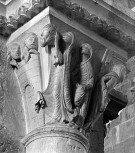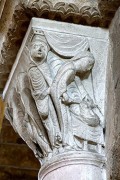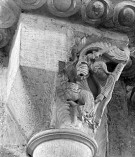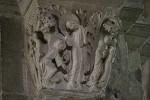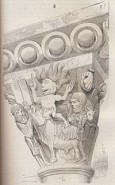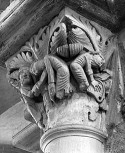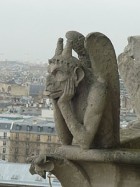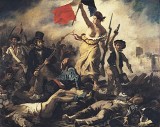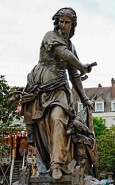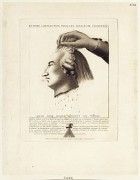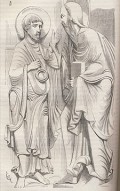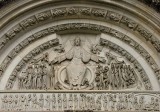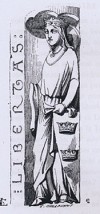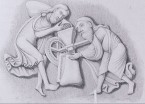The browser will either open the file, download it, or display a dialog.
In 1850, a decade into his massive restoration of the celebrated twelfth-century church of La Madeleine at Vézelay, Eugène-Emmanuel Viollet-le-Duc commissioned Michel Pascal, a Paris-based sculptor, to produce seven modern capitals to replace badly damaged medieval works in the nave.[1] Based on detailed archeological drawings provided by Viollet-le-Duc, Pascal's carvings demonstrate a remarkable fidelity to the composition, style, and subject matter of the fragments that they replaced.[2] However, in a single case the restorers introduced into the nave a carved narrative that had no archeological foundation. The modern capital of Judith decapitating and then raising aloft the severed head of the Assyrian lord, Holofernes (figs. 1, 2), replaced a medieval carving of a siren, today preserved in the archeological museum adjacent the church.[3] At first glance, this choice of narrative appears inscrutable because it lacks any historical or archeological justification. Indeed, not a single sculpture from the scores of Romanesque sites in Burgundy features a scene from the book of Judith.[4]
What precisely motivated the introduction of the Judith capital into Vézelay's nave has long puzzled scholars. Léon Pressouyre described the sculpture as an "inexplicable intrusion"; Francis Salet deemed it a "bad copy," and Lydwine Saulnier regarded it as simply stupefying.[5] Jean Nayrolles recently pointed out that the Judith capital demonstrates an exceptional sensitivity to Romanesque formal language that is rarely observed in nineteenth-century carvings.[6] Yet this brief apology for the work's style did not attempt to account for the choice of subject matter.
If art-historical scholarship has tended to discount the significance, both artistic and intellectual, of nineteenth-century restorations of Romanesque sculpture,[7] this article adopts a different vantage point, assessing the Judith capital as a serious work of art, worthy of study in its own right. I suggest that this sculpture serves as a trans-historical site that enabled a medieval monument to speak to nineteenth-century concerns, perhaps most saliently situating the medieval church within a discourse of French nationalism.[8] This argument must be inferred, for no documents directly address the motivations for the introduction of the Judith story at Vézelay.[9] Viollet-le-Duc's rather extensive writings on the site, both published and unpublished, concentrate on the site's architecture and offer only occasional brief comments on sculpture. The architect executed many drawings of the medieval sculpture that demonstrate a profound sensitivity,[10] but my research has not uncovered a preliminary drawing for the Judith capital. Likewise absent are any reports concerning how nineteenth-century viewers understood this modern sculpture. One must turn elsewhere to excavate the complex of motivations for the introduction of the Judith and Holofernes story into Vézelay's nave.
There have been numerous forays into illuminating the ideologies that informed nineteenth-century restorations of medieval monuments, but within these studies Romanesque sculpture has received relatively little attention.[11] There are good reasons for this relative silence with respect to France, for early restoration theories tend to concentrate on architecture and often overlook the question of monumental sculpture altogether. Antoine Chrysostôme Quatremère de Quincy (1755–1849) penned the most analytical passages in French on sculptural restoration from the period. A leading figure in archeological and architectural circles, Quatremère, among others, supervised the 1791–92 transformation of Paris's Sainte-Geneviève into the Panthéon, was appointed Intendant des Arts et Monuments Publics in 1815, and held a professorship of archeology and served as secretary of the Académie des Beaux-Arts. His widely read 1832 architectural dictionary stressed that sculpture contributes much to buildings: "it endows them with life; it diversifies them; it creates needs that become pleasures; its objects allow us to better appreciate distances, proportions, scales and measures."[12] Quatremère identified two modes of repairing sculpture within a building.[13] "Restitution" is an educated guess based on evidence culled from archeological and textual sources, whereas "restauration" continues an ornamental décor based on physical remains.
The notion of uniformity or homogeneity that underlies these two practices anticipates much in the work of Viollet-le-Duc, including the restoration of the nave sculpture at Vézelay.[14] Unlike the carvings housed in the adjoining narthex, many of which had been severely damaged or completely destroyed,[15] the ninety-nine twelfth-century nave capitals were relatively well preserved when Viollet-le-Duc arrived at the site in 1840. Except in the case of the Judith capital, the architect consistently took pains to respect medieval forms in his restoration of the nave sculpture. Three different approaches can be identified. First, Viollet-le-Duc restored a scene of David and Goliath by adding modern infillings to the extant portions of the medieval carving.[16] A second mode, similar to Quatremère's mode of restitution, can be observed in the six nineteenth-century capitals introduced into the nave that were based on the subject matter and compositions of the medieval fragments they replaced: Animal Musicians; Animals worshiping the Cross; the Funeral of Paul the Hermit; Raphael binding the Demon Asmodeus; a scene that may be the Temptation of Anthony; and a foliate capital.[17] Third, a capital of the Murder of Pharaoh's firstborn today includes a modern unformed block, clearly distinguishable from the medieval carving at right (fig. 3).[18] In this case, no effort was made to suggest the original appearance of this carving. Despite his use of different modes of restoration, Viollet-le-Duc typically did not make verbal distinctions among them, but used the term "restoration" in an expansive sense.[19]
Even if Viollet-le-Duc largely followed Quatremère's stridently archeological approach to sculptural restoration, he repeatedly distanced himself from his senior colleague in published writings. There were some theoretical points of disagreement between the two men, but the young architect's rhetorical positioning may have been driven in part by extraneous factors, largely political in nature. First, as will be argued below, Viollet-le-Duc embraced Republicanism, while Quatremère maintained that a monarch should play a role in government.[20] Quatremère's political views were widely known. He was forced to live in exile in Germany from 1796 to 1800 after his association with a failed royalist coup. After returning to France, he wrote a number of pamphlets that advocated for the establishment of a constitutional monarchy on the model of Great Britain.[21] Second, Viollet-le-Duc took issue with the policy of the Académie des Beaux-Arts to exclude instruction of medieval architecture from its curriculum, for he believed that the Gothic represented a truly national style that was worthy of study and emulation.[22] In contrast, the long-time affiliate of the Académie occasionally criticized medieval art and even went so far as to describe Gothic architectural decoration as incoherent. Quatremère regarded classical art to be the authoritative language, from which the dialect of Gothic architecture derived.[23]
Viollet-le-Duc differed with Quatremère's theories of the restoration of ancient buildings on one crucial point: he believed that a modern architect could confer on historical buildings a state of unity more perfect than even that which existed at any moment in history.[24] Viollet-le-Duc's writings failed to articulate the specific criteria that an architect might use in order to determine what, within a given building, might legitimately be altered to achieve that goal, especially with respect to monumental sculpture. It is clear, however, that Viollet-le-Duc believed that the scientific study of style was crucial for any successful sculptural restoration. In his ten-volume Dictionnaire raisonné de l'architecture française du XIe au XVIe siècle, Viollet-le-Duc noted that the Middle Ages held a carefree attitude toward the restoration of architectural capitals:
If it became necessary to replace a capital in a twelfth-century building, this single missing bit was replaced by an ornament in the taste of the moment, with a capital of the 13th, 14th, or 15th century. It often happened before the scrupulous study of styles that these modifications were regarded as anomalies and, in the process, incorrect dates were given to fragments that should be more properly regarded as interpolations in a text.[25]
The crime of interpolation here lies in the juxtaposition of the styles germane to two different eras; architectural decoration should be homogenous in style, reflective of a single historical moment that is synchronous with its surrounding architectural fabric. Soon after this passage, he reuses the interpolation metaphor to describe the restorer who erroneously substitutes a later form for an earlier form.
In many respects, despite its apparent disregard for the medieval fragment it replaced, the Judith capital adheres to Viollet-le-Duc's theories of restoration. His lengthy entry on sculpture in the Dictionnaire raisonné focuses largely on the analysis of physiognomy, anatomy, and dress of figures, both Romanesque and Gothic; these emerge as the essential attributes of any historical style.[26] A similar conception of style informed the Judith capital's attenuated figures donning intricately articulated drapery, which strongly resemble medieval sculptures from the church of St-Lazare, Autun, (fig. 4) a site that had received much attention among French archeologists beginning in the 1830s.[27] In addition to style, the arrangement of figures on the basket of the Judith capital conforms to conventions identifiable at Vézelay.[28] Viollet-le-Duc's drawing in the Dictionnaire of Vézelay's celebrated capital of Moses and the Golden Calf (fig. 5) shows the patriarch, the Golden Calf, and a demon clashing at the left corner of the capital. The pronounced cants of the abacus and impost block in this drawing lead the viewer's eye toward this point of narrative climax. These choices in the drawing's composition suggest that the architect was extremely attuned to the ways in which Vézelay's sculptors exploited the shape of the capital basket to relate stories. Even the placement of a separate scene on the right side of the Judith capital has numerous parallels elsewhere at the site. In a capital of Moses slaying the Egyptian, for example, the patriarch murders his enemy on the capital's main face and hides the severed head of his victim on the right side (fig. 6).
If the style and composition of the Judith capital align with Quatremère's notion of restoration, its subject matter might be described as a thematic restitution. As with most of the nave capitals that feature narratives, this sculpture, one of seven with a figure that has lost his head or is about to be decapitated by the swipe of a sword, represents a story from the Old Testament.[29] There is something potentially playful in this response of the nineteenth-century restorers, for these scenes of decap-itation seem to undermine the structural function of the cap-ital. Viollet-le-Duc's enduring interest in the functional aspects of medieval architecture may have made him particularly attentive to such visual play.[30]
The success of the Judith capital as a restoration can be surmised from the fact that Arthur Kingsley Porter, a leading authority of Romanesque art, judged it to be a masterpiece of medieval carving. The Harvard professor singled out this work from among the scores of capitals at Vézelay in a paragraph-long discussion in his 1923 Romanesque Sculpture of the Pilgrimage Roads.[31] Porter argued that the sculptor of the Judith capital was the master of the celebrated Pentecost tympanum at Vézelay, a work that he believed, in turn, exerted a heavy influence on the sculpture of St.-Lazare, Autun. Subsequent studies have often reiterated Porter's arguments and even today many image databases, including ARTstor, continue to date the Judith capital to the twelfth century.[32]
Francis Salet, the great historian of medieval architecture, voiced impatience with Porter's mistake. Though the following passage refrains from naming anyone directly, there can be no doubt that the American bears the brunt of the Frenchman's biting critique:
Failing to have inspected the sculptures of La Madeleine closely, failing to have studied the accounting records [of the restoration], archeologists, for the most part foreigners, have spoken without discernment of the "vandalism of the restoration," of the "scraping of the capitals," and have asserted that all these works were heavily restored and "returned to their original state," as they appeared at the time of the consecration of the church. Confusing ancient with modern, archeologists enthuse over the worst of the copies, the detestable Judith capital, which is attributed to "the most seductive sculptors of Vézelay" and in greatest earnest compared to the admirable sculptures of Autun! These fables are groundless: the general public continues to blame Viollet-le-Duc for misdeeds he did not commit.[33]
Salet casts Viollet-le-Duc as a savior of the architecture of Vézelay, but as something of a vandal of the building's sculpture.
This view strikes me as overstated, for, as I have argued, many aspects of the Judith capital demonstrate a remarkable sensitivity to Romanesque art in general and to conventions at Vézelay in particular. That said, Viollet-le-Duc undoubtedly jettisoned any historical or archeological grounding for his Judith capital by introducing new subject matter. He employed a similar modus operandi in other work at other medieval sites. The gargoyles he introduced on the exterior of the apse at Reims cathedral and on the balustrade of the west façade of Notre-Dame in Paris (fig. 7) are extraordinarily playful creations with virtually no basis in the archeological record.[34] In a groundbreaking and imaginative study, Michael Camille argued that these nineteenth-century gargoyles addressed a host of anxieties that accompanied the advent of modernity.[35] The Judith capital can further expand our understanding of Viollet-le-Duc's work as a restorer of sculpture, nuancing Camille's rather extreme claims that the architect "was not an iconographer" and that his motivations for sculptures were "pictorial rather than textual."[36] To be sure, the Judith story, which culminates in a grisly murder, perhaps aligns with Viollet-le-Duc's enduring fascination with the monstrous. In addition to gargoyles, his drawings, including those published in the Voyages pittoresques et romantiques de l'ancienne France,[37] often feature nightmarish scenes. But to consider only the sensational or monstrous aspects of the Judith story fails to fully account for the powerful ways in which this biblical heroine resonated with a host of nineteenth-century concerns.
Judith fascinated many nineteenth-century artists, as paintings by Jean-Joseph Benjamin-Constant and Francisco de Goya attest.[38] Texts dedicated to the heroine include an 1839 play by Friedrich Hebbel, in which Holofernes impregnates Judith before she decapitates him. This drama served as a touchstone for Sigmund Freud's development of his theory of the Oedipus complex.[39] Several other authors likewise eroticized the biblical heroine, typically cast as a usurper and castrator. Gustav Klimt's well-known painting of Judith stems from this tradition. Viewed from this perspective, the Judith capital might even be construed as a reasonable substitution for the medieval carving of the siren, a creature that likewise seduced and murdered men.
A fascination with sexually powerful and dangerous women can be identified in the novellas of Prosper Merimée, many of which feature a femme fatale as protagonist or deuteragonist.[40] Merimée, who was Inspector General of Historical Monuments and who had been trained as an archeologist, maintained a keen interest in the specifics of Viollet-le-Duc's restoration of medieval buildings, including work at Vézelay. [41] The tone of the two men's voluminous correspondence is consistently amicable, though I am unaware of any discussion of Merimée's fiction in their letters. Nevertheless, their correspondence reveals that they met rather frequently, and it seems reasonable to assume that Viollet-le-Duc had at least some knowledge of his friend's fiction.
Merimée's 1847 Carmen, which inspired Georges Bizet's opera, follows the eponymous anti-heroine as she seduces the soldier, Don José. After falling madly in love with Carmen and abandoning his former lover, the inexperienced soldier rebels against his military superiors and even becomes a smuggler. Don José is crushed when the free-loving gypsy turns her attentions to a bullfighter; the fallen soldier then murders Carmen. Such psychosexual dramas could even extend to archeology, most saliently in Merimée's Venus of Ille, which radically recast the Pygmalion myth.[42] The story begins with an archeologist recounting his travels to examine a recently excavated Roman bronze of Venus. The scholar soon becomes embroiled in a tragedy involving his wealthy host's son, who is betrothed to be married. In order to better play a ball game on the day before his wedding, the young man places a diamond ring on a finger of the statue. During the game, the statue bends her finger so that the man cannot remove the ring, which he had intended to give to his bride. The bridegroom is subsequently murdered on his wedding night, presumably by the jealous statue that would not tolerate her betrothed's infidelity.
Other similar examples could be cited in Merimée's corpus of fiction, but suffice it to say that the interweaving of sexual attraction and danger characterized his fiction, and has obvious parallels to the Judith story. What is more, by 1850 Biblical scholars widely recognized the many historical inaccuracies within the book of Judith, which had long been rejected as non-canonical by Protestants and many Jewish scholars; some even regarded the book as an early, perhaps even the first, historical novel.[43]
While Viollet-le-Duc's Judith might be regarded as yet another nineteenth-century example of the femme fatale, it should be emphasized that French visual culture featured militant women in decidedly positive terms. Eugène Delacroix's 1831 painting of Liberty Leading the People (fig. 8) helped to crystallize this favorable view for the national imaginary.[44] Maurice Agulhon and T.J. Clark have both argued that this visualization of the events of 1830 had a complex reception after the 1848 revolt,[45] when a number of painters, including Honoré Daumier, Delacroix, and Jean-François Millet, reconsidered how to best personify the Republic and its virtues, such as Justice and Truth. Perhaps most pressingly, given ubiquitous anxieties about class relations, should such images be associated with those who had perpetrated the violence of the barricades or should personifications remain aloof from the potentially unsavory associations of the events on the streets?
A satisfactory solution to this question eluded painters in the short-lived second republic, but it should be added that sculptors grappled with a similar question. Gabriel-Vilal Dubray's 1851 bronze of Jeanne Hachette at the Siege of Beauvais (fig. 9) casts the heroine in stridently militant fashion, represented in the act of defending her city from the invading troops of Charles the Bold, duke of Burgundy. The dynamically posed figure of Jeanne owes much in its conception to the personification of Liberty in Delacroix's 1831 painting, but the sculpture radically isolates the heroine from her comrades-in-arms. The removal of the figure of Jeanne from the specifics of this historical event can be seen as an effort to endow her struggle with universal significance.
Judith, a figure with no direct connection to French history, offered a similar advantage, namely, the distance afforded by biblical allegory. Significantly, the heroine's decapitation of Holofernes featured prominently in the cultural field of nineteenth-century France.[46] Plays about the Old Testament heroine were commonly staged from 1789 onward as a way to celebrate the tyrants who had fallen.[47] Prior to the Revolution, the biblical heroine was typically featured as the Queen of Hearts in playing cards, but this practice shifted during the Revolution, when Judith was replaced by a personification of Liberty. As the nineteenth century progressed, Judith reemerged as the Queen of Hearts,[48] but her meaning doubtless read very differently in the wake of tumultuous events.
During the nineteenth century, Judith was often conflated with Charlotte Corday.[49] Simone de Beauvoir even echoed this association at the middle of the twentieth century.[50] Corday had murdered Jean-Paul Marat for his revolutionary excesses and she, in turn, was subsequently executed for this act. By the middle of the nineteenth century, many with Republican sympathies regarded Corday as a heroine, comparable to Judith, because she had single-handedly saved France from the hands of a bloodthirsty Marat.[51] In the spring of 1850, François Ponsard's play, Charlotte Corday, opened at Paris's Comédie Française and starred an up-and-coming actress coincidentally named Madame Judith.[52] This play would have likely been known within Viollet-le-Duc's circle, for Merimée had tracked Ponsard's productions with interest.[53] Because of Ponsard's highly political theme, Republican troops, armed with bayonets, were stationed outside of the theater to prevent riots.[54] In a pivotal scene in which Corday contemplates whether or not to murder Marat, the heroine reads passages from the book of Judith to the audience and then addresses the ghost of Judith to ask what she demands.[55] The monologue continues with an invocation of the great authors that had written against political tyranny, including Plutarch and Jean-Jacques Rousseau. Corday then reads aloud a passage from the Baron de Montesquieu praising the armed citizens of the Roman Republic. Corday concludes her speech by declaring that the examples of Judith and Brutus compel her to execute Marat.
The guillotine—the instrument of death for tyrants and other enemies of the state—had effectively functioned as the Judith of the Revolution, and likewise, over the course of the nineteenth century, came to be regarded as a femme fatale, dubbed, among others, "Dame Guillotine" or "Sainte Guillotine."[56] The caption on Adolphe Léon Willette's 1887 print of a woman, wearing only a Phrygian cap and leaning against a guillotine, vividly encapsulates, however ironically, how nineteenth-century audiences regarded this machine: "I am Saint Democracy. I await my lovers."[57] A similar condensation of death and sexuality might be identified in Viollet-le-Duc's Judith, because unlike the many medieval capitals with scenes of decapitation at Vézelay, which all feature male executioners, his capital features a female protagonist.[58]
Judith's agency is highlighted on the Vézelay sculpture by the fact that she holds a severed head aloft. By the middle of the nineteenth century, this gesture had become emblematic of the Revolution. The spare composition of a hand raising a severed head was repeated in a number of anonymous prints to celebrate the deaths of traitors and tyrants, including Louis XVI (fig. 10). Villeneuve adopted this same gesture in his 1793 print Ecce Custine, which celebrated the execution of a count found guilty of treason for abandoning French troops to be slaughtered by Prussian forces. Linda Nochlin notes that the representation of body fragments, most notably severed heads, "for the Revolution and its artists, rather than symbolizing nostalgia for the past, enacts the deliberate destruction of that past, or, at least, a pulverization of what were perceived to be its repressive traditions."[59] To this day the gesture of raising a severed head continues to signal regicide and Republican ideals in French visual culture.[60]
The widespread tyrannicidal associations of Judith complemented the ways in which many nineteenth-century historians understood the medieval history of Vézelay, which they cast as the site of the first commune in France. This claim rested on a chronicle penned by Hugh of Poitiers in the 1160s.[61] In the prologue to his text, Hugh explains that he writes to record the travails of his monastery as it struggled to maintain control, both economic and juridical, over its vast holdings. Hugh's chronicle not only offered his narrative of events, but likewise included transcriptions of various charters and other legal documents that supported Vézelay's juridical and real property claims.
Augustin Thierry identified in Hugh's text a struggle of the bourgeoisie against the oppressive institution of the Church in his 1827 Lettres sur l'histoire de France.[62] This wide-ranging study comprising 25 chapters outlined the history of the French people's desire for liberty—a desire he characterized as unparalleled by that of any other people on earth.[63] Thierry identified three "communes" from the Middle Ages: Laon, Reims, and Vézelay. With respect to Vézelay, which predated the two examples from the thirteenth century, he argued that three events recorded by Hugh demonstrate a "hope for liberty" on the part of the townspeople: the assassination of Abbot Artaud in 1104; the 1137 agreement between the monastery and its servants; and the 1152–53 ousting of the monks by the townspeople. The historian argued that although roughly five decades separated these events, they were driven by a common purpose, namely, the attempt of the townspeople of Vézelay to organize a "commune." This term was far from innocent, for it had been applied already in 1789 to the events leading to the formation of the first Republic. Subsequent insurgencies would legitimize their actions by labeling them communes. Although Thierry's stated ambition for writing his history was to seek repose from the political agitations of his day, his nomenclature obviously spoke largely to contemporary concerns. Readers responded very favorably, as attested by the many editions and revisions that appeared well into the 1860s, some forty years after its initial publication. Even Viollet-le-Duc used the word "commune" in his description of the events at Vézelay in his architectural dictionary, citing the work of Thierry several times.[64]
In 1848, Léon de Bastard offered a lengthy critique of what he deemed to be Thierry's largely unfounded speculations. Regarding the assassination of Abbot Artaud, Bastard rightly noted that there was no evidence that this could even be attributed to the townspeople of Vézelay, much less evince a "commune."[65] The 1137 agreement, Bastard argued, applied only to the rustici—the men of the abbey—and not to the higher social classes, including the bourgeoisie. Accordingly, this did not constitute a communal movement that would warrant Thierry's political terminology.[66] Despite these objections, Bastard ultimately agreed with Thierry that the 1153 uprising could be construed as a commune, though he believed that it was compromised from the outset: the granting of rights to the rustici in 1137 ultimately limited the scope of the 1153 insurrection of the bourgeoisie, who could not mobilize the largely satisfied underclass. As a result, the revolt failed to enact any significant changes and the power of the clergy remained largely intact. Other historians writing in the 1850s and 1860s reached similar conclusions, including Antoine Chérest.[67]
For these nineteenth-century historians, events at Vézelay augured the rise of the secular mindset of the thirteenth century, in contradistinction to the piety that they believed characterized the twelfth century.[68] According to this line of thinking, the 1200s marked the period when Frenchmen began the process of overthrowing the bonds, both juridical and intellectual, of the Church. Merimée and Viollet-le-Duc argued that the concomitant flourishing of Gothic architecture was no accident, for it marked the widespread embrace of a truly national French style. Under such a schema, the Romanesque church of Vézelay, the site of an early commune, could be construed as a twelfth-century harbinger of the "secular" late Middle Ages. Indeed, in his architectural dictionary Viollet-le-Duc singled out the figures of Peter and Paul on the portal of Vézelay (fig. 11) as being indebted to arid conventions of Byzantine painting, but that the treatment of their gestures manifested an astonishing exactitude that would come to characterize Gothic sculpture.[69]
Viollet-le-Duc's 1856 "restitution" of the tympanum on Vézelay's west façade (fig. 12) can be seen to advance a similar teleological argument.[70] This carving is located above a portal that yields access to an 1140s narthex that was added to adjoin the western end of the nave, a structure completed by the end of the 1120s. By the nineteenth century, the medieval tympanum of the west façade had been badly damaged, with only a handful of figures discernible. In addition to a large silhouette at center, doubtless that of Christ, a badly damaged scene of Mary Magdalen washing Christ's feet was distinguishable on the lintel. Viollet-le-Duc ordered from Pascal a tympanum featuring a scene of the Last Judgment.[71] The architect's choice of subject was a reasonable conjecture, for it conforms to a subject that is featured on Gothic tympana across France, often likewise located above the central portal of west façades. It is precisely this conformity to broader conventions that likely motivated the execution of the elaborate and expensive modern tympanum at Vézelay. In subject and style, the work effectively casts the building's history as culminating in the Gothic, with all its attendant associations, many of which had nationalistic undertones.[72]
Developments in politics and art, especially sculpture, were intertwined for Viollet-le-Duc.
The evolution of French art coincides with an important historical fact: the development of a communal spirit, the weakening of the monastic state, and the dawn of a political unity manifesting itself primarily by the power asserted by royalty. The art of sculpture belongs to the laity; sculpture emancipates itself from monastic tutelage with the freedom enjoyed by new schools near the end of the twelfth century.[73]
The anti-clerical sentiment evident here had long been held by many French proponents of Enlightenment ideals—one need only think of scathing passages in Denis Diderot's encyclopedia—and was a view, as noted earlier, that was widely held in Viollet-le-Duc's circle. What is interesting here, and in the pages that follow, is the architect's assertion that sculpture flourishes at historical moments that enjoy a strong sense of l'état municipal. For Viollet-le-Duc, Periclean Athens, the cities of Northern France during the Gothic age, and Renaissance Florence attest to this causal relationship between a strong sense of a common body politic and the production of great sculpture.[74] In his Entretiens sur l'architecture, Viollet-le-Duc makes a similar argument, suggesting that sculpture tends to flourish when the state does not interfere in the arts.[75]
Camille and others have suggested that the politics of Viollet-le-Duc became increasingly difficult to discern as he aged.[76] In 1830, as a young man, the architect had joined the ranks of a barricade in Paris; 18 years later, in a letter to his father, the architect relates how he looked down from his Paris apartment window at the "wild beasts" that took to the streets.[77] Yet too much can be made of this letter, for bourgeois and well-educated individuals often looked with ambivalence at "the People" and their actions in 1848, even if they ultimately supported the fight for Liberty. The celebrated author George Sand is a case in point. Committed to the surge of democratic sentiment in 1848, she, nevertheless, several times expressed reservations. In a letter to Giuseppe Mazzini, she described her compatriots as, among others, "blind" and "ungrateful".[78] In short, to condemn the rabble was not tantamount to disavowing Republican ideals.
Viollet-le-Duc repeatedly cast medieval archeology in terms of a nationalist agenda. We have already seen that in 1846 he published a scathing essay arguing for the study of Gothic architecture to be added to the curriculum of the Académie des Beaux-Arts, repeatedly asserting that this was a truly French style with which the nation's architects should be well acquainted.[79] In 1848, just before the February uprising, the architect, along with Pascal, were listed among the founding members of the Société d'Archéologie Nationale, which aimed to make archeology a science and an educational tool.[80] The organization was staunchly nationalistic and, unlike previous archeological organizations, listed no ecclesiastics among its members. Yet by the end of the following year the group had effectively failed.[81] In a letter to Viollet-le-Duc dated November 8, 1849, Ferdinand de Guilhermy, vice president of the society, lamented the resistance by powerful figures in the field, most notably Adolphe-Napoléon Didron, to the effort to "republicanize and dethrone" archeology.[82]
Author of the monumental Iconographie chrétienne: Histoire de Dieu,[83] Didron was the founding president of the Société nationale d'archéologie and occasionally demonstrated Republican sympathies in his scholarship.[84] For example, he argued, albeit very tenuously, that the eighteenth-century figure of Liberté with her Phrygian cap ultimately descended from the same tradition as a crowned sculpture of Libertas at Chartres (fig. 13): both shared the attribute of headgear and both manifested a national yearning for freedom.[85] Yet in this same article, Didron embraced Christianity as enlightened and as an essential lens for understanding medieval art. Such views stand at odds with the stridently anti-clerical positions of Viollet-le-Duc, who tended to cast medieval art in almost exclusively secular terms.
Viollet-le-Duc's preparations for the Judith capital began a few short months after the demise of the national archeology society. It is tempting to identify in this choice of subject matter, which had stridently tyrannicidal connotations in mid-nineteenth-century France, a desire to keep a Republicanist agenda alive within the field of archeology. Doubtless, the contours of such a project would radically change after Napoleon III's ascent to the throne ended the Second Republic on December 2, 1851.
By way of conclusion, it is instructive to note that at roughly the same time Viollet-le-Duc was altering the sculptural fabric of Vézelay, an extremely influential interpretive model was being developed using the church's sculpture as a case study. In the 1840s and 1850s, the Jesuit priests Arthur Martin and Charles Cahier wrote a series of methodologically pioneering studies that took their cue from Didron, among others, by analyzing the abbey church's capitals with an eye to their religious meaning.[86] Their writings cast Romanesque sculpture as a theology in stone, a view that aligned well with the pro-Catholic sentiments of many powerful archeologists in the 1850s, especially in the wake of the failed second Republic.[87] Their illustration of Vézelay's so-called Mystic Mill capital (fig. 14) underscores this approach: it isolates the figures of Moses and Paul, divorcing them from the architectonics of the capital basket, and arranges them like an illustration from a book. Of course, a similarly textual approach would later be developed at the turn of the twentieth century, most influentially by Emile Mâle, and continues to permeate scholarly discourses on medieval art to this day.[88]
Viollet-le-Duc's interpolation of the Judith capital can be seen to mark an early, tangible example of a different interpretive strategy still in practice, namely to construe carvings of religious subjects in political terms.[89] Equipped with the benefit of hindsight, the architect perhaps felt that through his sculptural intervention he was able to offer a more unified political account of the site than was perhaps possible for its medieval artisans. As locus of the first commune, Vézelay was a harbinger of the ideals of the Republic, including the overthrow of tyrants and the love of liberty. Such sentiments could effectively be allegorized in the figure Judith, who had saved the people of Israel from oppressive rule through the murder of an enemy general. The introduction of this subject matter into Vézelay's nave was perhaps even seen to open up an alternative mode of sculptural restoration, one that would effectively serve to nationalize medieval monuments.
Perhaps more fundamentally than any political agenda, however, Viollet-le-Duc's Judith conjoins innovation, through the introduction of a new story, with a historically sensitive composition and style. It is this balance of old and new that suggests a thoughtfully staged dialogue between past and present. Such a restoration practice could ultimately serve to render a medieval monument modern.[90]
Earlier versions of this article were presented in lecture form at Columbia University (March, 2010) and the University of Pittsburgh (October, 2009). Members of both audiences offered useful comments for which I am most grateful. Thanks also are due to Marilyn Brown, who read an early draft of this article, and to this journal's anonymous reader for helpful suggestions.
[1] See the summary of restorations in Eugène-Emmanuel Viollet-le-Duc, Monographie de l'ancienne église abbatiale de Vézelay (Paris: J. Baur et Detaille, 1873). Assessments of Viollet-le-Duc's restorations at Vézelay include Pierre Meunier, "Mémoire des travaux de restauration exécutés à la Madeleine de Vézelay," in Canon Despiney, Guide Album de Vézelay (Vézelay: Magasin du pèlerin de Vézelay, 1930); Jean-Paul Midant, Viollet-le-Duc: The French Gothic Revival (Paris: L'Aventurine, 2002), 19–29; Kevin D. Murphy, Memory and Modernity: Viollet-le-Duc at Vézelay (University Park, PA: Penn State Press, 2000); Léon Paul, La vie des monuments français: Destruction, restauration (Paris: Picard, 1951), 371–77; Francis Salet, "Viollet-le-Duc à Vézelay," Monuments historiques de la France, n.s., 11 (1965): 33–42; Lydwine Saulnier and Neil Stratford, La sculpture oubliée de Vézelay (Geneva: Droz, 1984); Eugenio Vassallo, "Il progetto di restauro: Viollet-le-Duc e la Madeleine di Vézelay," in Saggi in onore di Renato Bonelli, ed. Renato Borelli and others (Rome: Multigrafica, 1992), 2:903–12; Robert Vassas, "Travaux à la Madeleine de Vézelay, voûtes de la nef," Monuments historiques de la France, n.s., 14 (1968): 56–61; Geneviève Viollet-le-Duc, Viollet-le-Duc à Vézelay, exh. cat. (Vézelay: Mairie de Vézelay, 1968). See also Arnaud Timbert, Viollet-le-Duc: Le chantier de restauration de La Madeleine de Vézelay; Correspondance (1840–1841) (Auxerre: Société des Fouilles Archéologiques et des Monuments Historiques de l'Yonne, 2005). A helpful, albeit sometimes inaccurate, biography of Michel Pascal was published shortly after the sculptor's death. Emile Berray, "Michel Pascal (1810–1882)," Le bulletin des beaux-arts 2 (1884–85): 163–84.
[2] In his roughly contemporary restoration carvings at Notre-Dame, Paris, Michel Pascal's work is virtually indistinguishable from those of Jean-Louis Chenillion or Armand Toussaint because all men were so closely following Viollet-le-Duc's drawings. See Michael Camille, The Gargoyles of Notre Dame: Medievalism and the Monsters of Modernity (Chicago: University of Chicago Press, 2009), 58.
[3] This is nave capital 46 according to the numeration system established by Salet in La Madeleine de Vézelay: Etude iconographique (Melun: Librairie d'Argences, 1948). Salet's system is employed throughout this article. For an overview of scholarship on this capital, see Kirk Ambrose, The Nave Sculpture of Vézelay: The Art of Monastic Viewing (Toronto: Pontifical Institute of Mediaeval Studies, 2006), 100.
[4] For a survey of Biblical themes in the capitals of the region, see Marcello Angheben, Les chapiteaux romans de Bourgogne: Thèmes et programmes (Turnhout: Brepols, 2003), 165–243.
[5] Léon Pressouyre, "Viollet-le Duc et la sculpture," in Viollet-le-Duc, ed. Editions de la Réunion des Musées Nationaux (Paris: Editions de la Réunion des Musées Nationaux, 1980), 145; Lydwine Saulnier, "Vézelay: La restauration de la sculpture," Editions de la Réunion des Musées Nationaux, Viollet-le-Duc, 152; Salet, "Viollet-le-Duc," 40–41.
[6] Jean Nayrolles, "Sculpture néo-romane: Entre modèles et invention," Cahiers de Saint-Michel de Cuxa 37 (2006): 265–79.
[7] Such negative judgments abound in scholarship on Romanesque monuments. Mathieu Méras, for example, described the nineteenth-century sculptural additions to the portal of Moissac as "unfortunate" (fâcheuses) in "Le restauration du portail de Moissac au XIXe siècle," Bulletin de la Société archéologique de Tarn-et-Garonne 85 (1959): 17.
[8] For another nineteenth-century case of casting a Romanesque monument in political terms, see Linda Seidel, Legends in Limestone: Lazarus, Gislebertus and the Cathedral of Autun (Chicago: University of Chicago Press, 1999), 1–32.
[9] The lack of documentation for this capital is discussed in Salet, "Viollet-le-Duc," 40–41. See also Saulnier and Stratford, Sculpture oubliée, 124.
[10] Several important drawings of the site were published, including those in vol. 2 of Anatole de Baudot and Jules Roussel, Dessins inédits de Viollet-le-Duc, (Paris: A. Guérinet, 1896).
[11] Nayrolles, "Sculpture néo-romane," 265–79.
[12] Samir Younés, The True, the Fictive, and the Real: The Historical Dictionary of Architecture of Quatremère de Quincy: Introductory Essays and Selected Translations (London: Papadakis, 1999), 229.
[13] Antoine Chrysostôme Quatremère de Quincy, Dictionnaire historique d'architecture (Paris: Adrien le Clere et Cie, 1832), 375–77. See also Younés, Historical Dictionary, 217–20.
[14] Later nineteenth-century critics of Viollet-le-Duc, including John Ruskin and Auguste Renoir, praised the irregularity of medieval artisanal production, including sculpture. See, for example, Robert L. Herbert, Nature's Workshop: Renoir's Writings on the Decorative Arts (New Haven: Yale University Press, 2000), 27.
[15] Four restored capitals within the narthex were complete inventions, with no archeological foundation for their appearance. This was, however, a result of the originals having been destroyed before Viollet-le-Duc began his restoration campaign. The Judith capital, by contrast, is clearly a motivated alteration since it replaces a medieval work whose subject was known.
[16] For an overview of scholarship on nave capital 50 see Ambrose, Nave Sculpture, 101–2.
[17] Respectively, these are nave capitals 9, 13, 58, 76, 63, and 64. In addition to respect for the archeology of the site, there may have been other motives for preserving the capital that Viollet-le-Duc believed represented the Temptation of Anthony. For one, the saint emerged as a figure of fascination during the mid nineteenth century in France, as Jean Seznec has argued in his magisterial study of Gustave Flaubert, Nouvelles études surLa Tentation de Saint Antoine (London: Warburg Institute, University of London, 1949). Within Viollet-le-Duc's circle, Prosper Mérimée wrote a short play likewise entitled, La Tentation de Saint Antoine. This work, set in a Spanish monastery, serves as a thinly disguised vehicle to advance anti-clerical views that were shared by Viollet-le-Duc.
[18] For an overview of scholarship on nave capital 57, see Ambrose, Nave Sculpture, 103–4.
[19] Viollet-le-Duc, Dictionnaire raisonné, 8:14–34. I similarly use restoration in a broad sense, indicating Quatremère's more restrictive terms by "restitution" and "restauration".
[20] Sylvia Lavin, Quatremère de Quincy and the Invention of a Modern Language of Architecture (Cambridge, MA: MIT Press, 1992), 149–50.
[21] Ibid., 149.
[22] Eugène-Emmanuel Viollet-le-Duc, "Du style gothique au XIXe siècle," Annales archéologiques 4 (1846): 334.
[23] Lavin, Invention of a Modern Language, 170–71.
[24] "Restaurer un édifice, ce n'est pas l'entretenir, le réparer ou le refaire, c'est la rétablir dans un état complet qui peut n'avoir jamais existé à un moment donné." Eugène-Emmanuel Viollet-le-Duc, Dictionnaire raisonné de l'architecture française du XIe au XVIe siècle (Paris: B. Bance, 1858), 8:14. Translated by M.F. Hearn, as The Architectural Theory of Viollet-le-Duc: Readings and Commentary (Cambridge, MA: MIT Press, 1990), 269.
[25] "Fallait-il dans un édifice du XIIesiècle remplacer un chapiteau brisé, c'était un chapiteau du XIIIe, du XIVe ou du XVe siècle, un morceau, un seul, venait-il à manquer, c'était un ornement dans le goût du moment qu'on incrustait. Aussi est-il arrivé bien des fois, avant que l'étude attentive des styles fût poussée à ses dernières limites, qu'on était entraîné à considérer ces modifications comme des étrangetés, et qu'on donnait une date fausse à des fragments qu'on eût dû considérer comme des interpolations dans un texte." Viollet-le-Duc, Dictionnaire raisonné, 8:15, Hearn, Architectural Theory, 269. Unless otherwise indicated, all subsequent translations are the author's.
[26] Viollet-le-Duc, Dictionnaire raisonné, 8:97–279.
[27] Seidel, Legends in Limestone, 18–19.
[28] See, for example, the lengthy discussion of monumental capitals in Viollet-le-Duc, Dictionnaire raisonné, 2:480–544.
[29] Ambrose, Nave Sculpture, 73–85.
[30] For a recent assessment of Viollet-le-Duc's rationalist approach to Gothic architecture, see Roland Recht, Believing and Seeing: The Art of Gothic Cathedrals, trans. Mary Whitthall (Chicago: University of Chicago Press, 2008), 10–18.
[31] Arthur Kingsley Porter, Romanesque Sculpture of the Pilgrimage Roads (Boston: Marshall Jones, 1923), 1:114; 2: pl. 44.
[32] See, for example, Louis Bréhier, L'homme dans la sculpture romane (Paris: Librairie de France, 1927), pl. 26; Gottfried von Lücken, Burgundische Skulpturen des 11. und 12. Jahrhunderts (Leipzig: Klinkhardt & Biermann, 1923), 113, pl. 33.
[33] "Faute d'avoir regardé attentivement les sculptures de la Madeleine, faute d'avoir étudié les comptes et les devis, des archéologues, pour la plupart étrangers, ont parlé sans discernement de 'vandalisme de la restauration,' de 'ravalement des chapiteaux,' ont affirmé que tout avait été gratté et 'remis à neuf comme aux premiers jours de la consécration de l'église' et, confondant l'ancien et le moderne, se sont extasiés sur les plus mauvaises copies, le détestable chapiteau de Judith, par exemple, attribué par eux au 'plus séduisant de sculpteurs de Vézelay,' et rapproché des oeuvres admirables d'Autun avec une subtilité qui aurait pu s'employer à meilleur escient! La légende est indéracinable et le grand public continue d'accabler Viollet le Duc pour des méfaits qu'il n'a pas commis." Salet "Viollet-le-Duc," 40.
[34] Camille, Gargoyles of Notre Dame, 4–21. See also Marcel Aubert, La cathédrale Notre-Dame de Paris: Notice historique et achéologique (Paris: Firmin-Didot, 1945), 133.
[35] Camille, Gargoyles of Notre Dame, 40–50.
[36] Ibid., 42.
[37] Charles Nodier, Isidore-Justin-Séverin Taylor, and Achille-Alexandre-Alphonse de Cailleux, Les Voyages pittoresques et romantiques dans l'ancienne France, 18 vols. (Paris: P. Didot l'aîné, 1820–78).
[38] See the very helpful overview of Margarita Stoker, Judith, Sexual Warrior: Women and Power in Western Culture (New Haven: Yale University Press, 1998), 87–119.
[39] Ibid., 190–91.
[40] I consulted Pierre Trahard and Edouard Champion, Oeuvres complètes de Prosper Mérimée, 10 vols. (Paris: Champion, 1927–33); Prosper Mérimée, Carmen and Other Stories, trans. Nicholas Jotcham (Oxford: Oxford University Press, 1989).
[41] The tone and number of letters between these two men suggest their intimacy. See, for example, Prosper Mérimée, Lettres à Viollet-le-Duc (Paris: H. Champion, 1927); Prosper Mérimée, Correspondance générale, ed. Maurice Parturier, 17 vols. (Paris: Le Divan, 1941–64).
[42] Valérie-Angélique Deshoulières, "L'allégorie archéologique dans la littérature contemporaine: Les métamorphoses de Pygmalion depuis Mérimée," in Prosper Mérimée: Ecrivain, archéologue, historien, ed. Antonia Fonyi (Geneva: Droz, 1999), 39–50. In Merimée's novella Columba, a Corsican woman repeatedly goads her brother to violently avenge the death of their father. Columba resorts to a number of extreme measures in the effort to achieve her ends, including bearing false witness, fabricating evidence, and taunting her brother's manhood, even though he is a decorated soldier.
[43] The Catholic Encyclopedia, s.v. "Book of Judith," http://www.newadvent.org/cathen/ (accessed November 15, 2010).
[44] Linda Nochlin, "The Myth of the Woman Warrior," in Representing Women (New York: Thames and Hudson, 1999), 34–57.
[45] Maurice Agulhon, Marianne au combat: L'imagerie et la symbolique républicaines de 1789 à 1880 (Paris: Flammarion, 1979), 85–156; T.J. Clark, The Absolute Bourgeois: Artists and Politics 1848–51 (Greenwich, CT: New York Graphic Society, 1973), 31–71. See also Joan B. Landes, Visualizing the Nation: Gender, Representation, and Revolution in Eighteenth-Century France (Ithaca, NY: Cornell University Press, 2001).
[46] Stocker, Judith, Sexual Warrior, 111–19.
[47] Mieke Bal, "Headhunting: Judith or the Cutting Edge of Knowledge," in A Femininist Companion to Reading the Bible: Approaches, Methods, Strategies, ed. Athalya Brenner (Sheffield: Sheffield Academic Press, 1995), 253–85; Regina Jones, Losing Our Heads: Beheadings in Literature and Culture (New York: New York University Press, 2005), 82–90; Camille Naish, Death Comes to the Maiden: Sex and Execution 1431–1933 (New York: Routledge, 1991), 106–9. For imagery of the guillotine see also Daniel Arasse, The Guillotine and the Terror, trans. Christopher Miller (New York: Allen Lane/Penguin Press, 1988); Julia Kristeva, Visions capitales (Paris: Réunion des Musées Nationaux, 1998), 101–10; Ewa Lajer-Burcharth, Necklines: The Art of Jacques-Louis David after the Terror (New Haven: Yale University Press, 1999).
[48] William Gurney Benham, Playing Cards: History of the Pack and Explanations of its Many Secrets (London: Spring Books, 1931), 140–53, 171–77; Roger Tilley, Playing Cards (New York: G.P. Putnam's Sons, 1967), 64–67.
[49] Stocker, Judith, Sexual Warrior, 111–21.
[50] Simone de Beauvoir observes: "Judith, Charlotte Corday, Vera Zasulich were assassins; the Frondeuses were conspirators; during the Revolution, during the Commune, women battled beside the men against the established order. Against a liberty without rights, without powers, woman has been permitted to rise in refusal and revolt, while being forbidden to participate in positively constructive effort; at the most she may succeed in joining men's enterprises though an indirect road." The Second Sex, trans. H.M. Parshley (New York: Knopf, 1953), 130–31.
[51] See, for example, Naish, Death Comes to the Maiden, 120, 130–31; Stocker, Judith, Sexual Warrior, 164–66.
[52] Paul Gsell, Mémoires de Madame Judith de la Comédie Française et souvenirs sur ses contemporains (Paris: J. Tallandier, 1911). This version includes a number of illustrations by Laurent Gsell, including Madame Judith in the role of Charlotte Corday. The illustration is of Corday in a field holding a rake; this, to Madame Judith's mind, was the scene in which the audience turned to her favor. The illustrations are absent in Madame Judith, My Autobiography, ed. Paul G'Sell [sic] and trans. Arthur Bell (New York: G.P. Putnam & Sons, 1913).
[53] See, for example, Claude Schopp, ed., Lettres de Prosper Mérimée à Madame de Montijo (Paris: Mercure de France, 1995), 2:355.
[54] Gsell, Mémoires, 164.
[55] François Ponsard, Oeuvres complètes (Paris: M. Lévy, 1865), 1:277–79 (Act 2, scene 7).
[56] Regina Janes, Losing our Heads: Beheadings in Literature and Culture (New York: New York University Press, 2005), 90–92; Naish, Death Comes to the Maiden, 110–31.
[57] "Je suis la Sainte Démocratie. J'attends mes Amants;" Janes, Losing our Heads, fig. 3.5.
[58] Hélène Cixous notes: "It's the classic opposition, dualist and hierarchical. Man/Woman automatically means great/small, superior/inferior … means high or low, means Nature/History … work still has to be done on the couple, on the question, for example, of what a completely different couple relationship would be like, what a love that was more than merely a cover for, a veil of, war would be like." "Castration or Decapitation," Signs 7, no. 1 (1981): 44.
[59] Linda Nochlin, The Body in Pieces: The Fragment as a Metaphor of Modernity (New York: Thames and Hudson, 1994), 8. See also Arasse, Guillotine; Nina Athanassoglou-Kallmyer, "Gericault's Severed Heads and Limbs: The Politics and Aesthetics of the Scaffold," Art Bulletin 74, no. 4 (1992): 599–618.
[60] For example, a set of commemorative mustard cups was issued by Bornier on the 200th anniversary of the Revolution that featured an image of a severed head being raised adjacent to a guillotine. See Janes, Losing our Heads, 67–96.
[61] The text is preserved in one twelfth-century manuscript (Manuscrit 227, Bibliothèque Municipale d'Auxerre). This manuscript has been published in R.B.C. Huygens, ed., Monumenta Vizeliacensia: Textes rélatifs à l'histoire de l'abbaye de Vézelay, Corpus Christianorum Continuatio Mediaevalis 42 (Turnhout: Brepols, 1976). A partial English translation is available in John Scott and John O. Ward, Hugh of Poitiers: The Vézelay Chronicle (Binghamton: Medieval & Renaissance Texts & Studies, 1992).
[62] Augustin Thierry, Lettres sur l'histoire de France (Paris: Garnier, 1827). This work was revised in 1851, but in both the first and second editions the history of Vézelay is addressed in letters twenty-two to twenty-four.
[63]"L'esprit d'indépendence est empreint dans notre histoire aussi fortement que dans celle d'aucun autre peuple ancien ou moderne." Thierry, Lettres sur l'histoire de France, 3.
[64] "Si l'on se reporte au temps où fut sculptée la porte principale de l'église de la Madeleine, on observera que les moines de Vézelay avaient atteint un degré de puissance et d'influence tel, qu'il fallut près d'un siècle de luttes sanglantes entre ces religieux, les comtes de Nevers et les habitants de la commune de Vézelay, pour amoindrir ce pouvoir exorbitant." Viollet-le-Duc, Dictionnaire raisonné, 7:389.
[65] Léon de Bastard, "Recherches sur l'insurrection communale de Vézelay au XIIe siècle," Bibliothèque de l'Ecole des Chartes 12 (1851): 346. See also Léon de Bastard, "De la commune de Vézelay," Bulletin de la Société des sciences historiques et naturelles de l'Yonne 2 (1848): 527–52.
[66] Bastard, "Recherches," 352.
[67] See, for example, Antoine Chérest, "Vézelay: Etude historique II," Bulletin de la Société des sciences historiques et naturelles de l'Yonne 22 (1868): 150; reprinted in Huygens, Monumenta Vizeliacensia, 80.
[68] Jean Nayrolles, L'invention de l'art roman à l'époque moderne (XVIIIe-XIXe siècles) (Rennes: Presses Universitaires de Rennes, 2004), 211–25. See also Martin Bressani, "Notes on Viollet-le-Duc's Philosophy of History: Dialectics and Technology," Journal of the Society of Architectural Historians 48, no. 4 (1989): 338, 343–47.
[69] Viollet-le-Duc, Dictionnaire raisonné, 8:109
[70] For a detailed account of the original tympanum, see Saulnier and Stratford, Sculpture oubliée, 245–46
[71] Salet, "Viollet-le-Duc à Vezelay," 41–42.
[72] Kevin Murphy has argued that the architect altered the very architectural fabric to foster a sense of Gothic unity; Murphy, Memory and Modernity, 71–131.
[73] "Cette évolution de l'art français coïncide avec un fait historique important: le développement de l'esprit communal, l'affaissement de l'état monastique et l'aurore de l'unité politique se manifestant sous une influence prépondérante prise par le pouvoir royal. L'art de la statuaire appartient aux laïques; il s'émancipe avec ces nouvelles écoles affranchies, vers la fin du XIIe siècle, de la tutelle monastique." Viollet-le-Duc, Dictionnaire raisonné, 8:134.
[74] For analogous arguments by nineteenth-century art historians, see T.J. Clark, Absolute Bourgeois, 57. Viollet-le-Duc's embrace of the Gothic as a national French style in architecture has been recently discussed by Michela Passini, "Il nazionalismo e le origini della storia dell'arte: Francia e Germania 1870–1933" (PhD diss., Pisa, Scuola Normale, 2008).
[75] Eugène-Emmanuel Viollet-le-Duc, Entretiens sur l'architecture (Paris: Q. Morel et Cie, 1872), 2:217–52.
[76] Camille, Gargoyles of Notre Dame, 157–88. See also Paul Gout, Viollet-le-Duc: Sa vie, son oeuvre, sa doctrine (Paris: Champion, 1914), 135–39.
[77] Eugène-Emmanuel Viollet-le-Duc, Lettres inédites de Viollet-le-Duc, comp. Eugène Viollet-le-Duc (Paris: Champion, 1927), 11–12.
[78] Georges Lubin, ed., Correspondance de George Sand (Paris: Garnier Frères, 1970), 7:566.
[79] Viollet-le-Duc, "Style gothique."
[80] Adolphe-Napoléon Didron, "Statuts de la Société nationale d'archéologie,"Annales archéologiques 8 (1848): 237–41. See also Didron, "L'archéologie sous la république," Annales archéologiques 8 (1848): 164–71.
[81] See, for example, Camille, Gargoyles of Notre Dame, 64–66; Nayrolles, Invention de l'art roman, 206–11.
[82] Letter quoted in Jean-Michel Leniaud, Jean-Baptiste Lassus (1807–57) ou le temps retrouvé des cathédrales (Geneva: Droz, 1980): 40n122. As did Viollet-le-Duc, Didron envisioned the introduction of medieval archeology into the national curriculum and envisioned an invigoration of state-sponsored arts as a result; "Archéologie sous la république," 165–72.
[83] Adolphe Napoléon Didron, Iconographie chrétienne: Histoire de Dieu (Paris: Imprimerie royale, 1843). This work soon appeared in English as Didron, Christian Iconography: The History of Christian Art in the Middle Ages, 2 vols., trans. E. J. Millington (London: H.G. Bohn, 1851).
[84] A lengthy footnote to the statutes, signed by Didron, tries to distance the organization, founded in January of 1848, from the upheavals of February.
[85] Adolphe-Napoléon Didron, "Statuaire des cathédrales de France," Annales archéologiques 6 (1847): 51.
[86] See, for example, Charles Cahier and Arthur Martin, Mélanges d'archéologie, d'histoire et de littérature, rédigés ou recueillis, 4 vols. (Paris: Poussielgue-Rusand, 1847–56); Charles Cahier and Arthur Martin, Nouveaux mélanges d'archéologie, d'histoire et de littérature sur le Moyen Age, 4 vols. (Paris: Firmin Didot, 1874–77).
[87] Nayrolles, Invention de l'art roman, 211–25.
[88] Emile Mâle, L'Art religieux du XIIe siècle en France: Etude sur l'origine de l'iconographie du Moyen Age (Paris: Colin, 1922). For the persistence of this model see, for example, Robert A. Maxwell, review of L'image à l'époque romane, by Jean Wirth, and his review of Le croire et le voir: L'art des cathédrales (XIIe-XVe siècles), by Roland Recht, Art Bulletin 83, no. 4 (2001): 757–61.
[89] Viollet-le-Duc's political arguments have resurfaced in recent scholarly literature. For example Viollet-le-Duc interpreted the lintel below the Pentecost tympanum as a scene of donations to the monastery; Dictionnaire raisonné, 7:389. This thesis was reprised in Kristin Sazama, "The Assertion of Monastic and Spiritual and Temporal Authority in the Romanesque Sculpture of Sainte-Madeleine at Vézelay" (PhD diss., Northwestern University, Evanston, IL, 1995).
[90] For a similar argument concerning the restored architecture of Vézelay, see Murphy, Memory and Modernity, 7–8.


